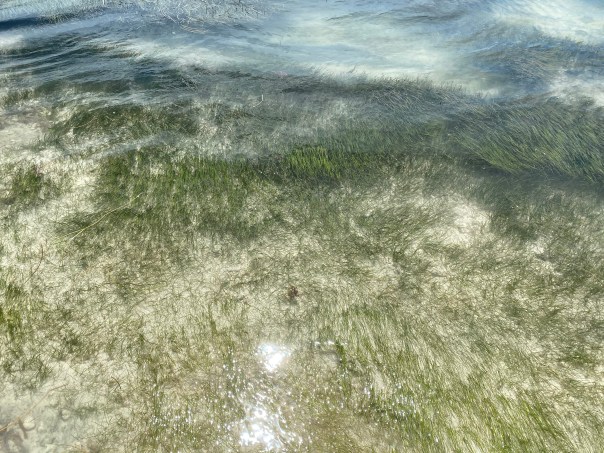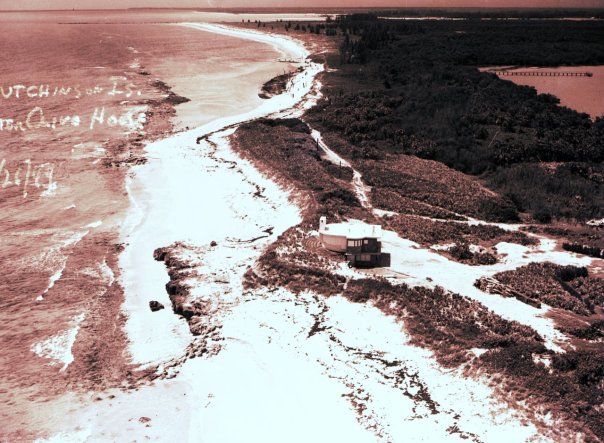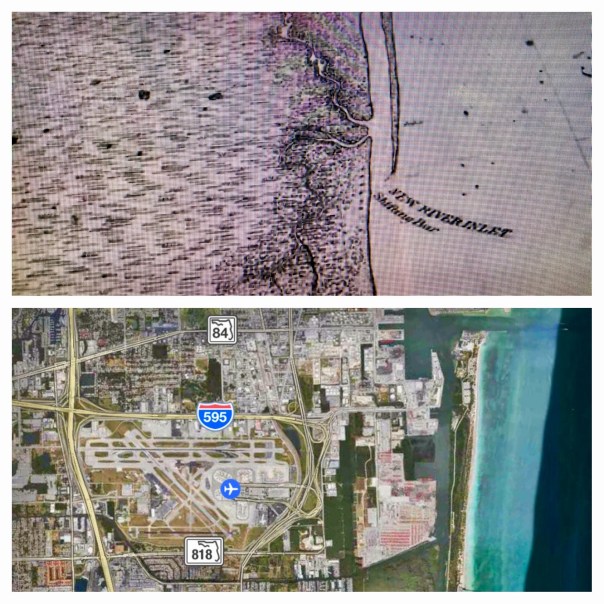Tales of the Southern Loop, Stuart to Boyton, Part 1
Tales of the Southern Loop, Boyton to Miami, Part 2
Tales of the Southern Loop, Miami to Tavernier, Part 3
Tales of the Southern Loop, Tavernier to Marathon, Part 4
Tales of the Southern Loop, Marathon to Key West, Part 5
 The trip from Marathon to Key West was stunning. The sun was shining, it was the 11th of September, 2020, and the water was turquoise blue. Ed rounded Adrift under the Seven Mile Bridge, once the area of Henry Flagler’s famous Oversees Railroad.
The trip from Marathon to Key West was stunning. The sun was shining, it was the 11th of September, 2020, and the water was turquoise blue. Ed rounded Adrift under the Seven Mile Bridge, once the area of Henry Flagler’s famous Oversees Railroad.
-Entering the Atlantic- going under the 7 Mile Bridge, Key West

 After about an hour, I noticed something. I walked up the ladder to the upper helm.
After about an hour, I noticed something. I walked up the ladder to the upper helm.
“Babe when you come down can you tell me if it smells down here?”
“What smells,” Ed asked. “
“The cabin.”
“The salon? It smells? Did you flush properly?” he inquired.
I rolled my eyes, “yes,” I replied, wondering if I did hold the foot pedal down long enough to draw water.
We had another five hours before we reached Key West; I decided to put “the smell” out of my mind. As we looked out upon liquid glass water, I could see Ed smiling, stress free.
-Ed looks upon the blue Atlantic!
 The trip was absolutely beautiful. It was quiet and the water was almost like a blue mirror. I knew that the Keys, like all Florida, has water issues, but on a day like today you would never know. Ed and I enjoyed looking back and forth at each other so pleased that we had decided to actually take this trip. Taking three weeks off was something Ed had never done before; we both agreed to do it NOW as “we’re not getting any younger.”
The trip was absolutely beautiful. It was quiet and the water was almost like a blue mirror. I knew that the Keys, like all Florida, has water issues, but on a day like today you would never know. Ed and I enjoyed looking back and forth at each other so pleased that we had decided to actually take this trip. Taking three weeks off was something Ed had never done before; we both agreed to do it NOW as “we’re not getting any younger.”
I climbed around the bow and again walked up the ladder. “On my deathbed I am going to be so glad we took this trip!” I shouted.
Ed smiled,“Always the optimist!” he replied.
I laughed and returned to the kitchen to make lunch.
“I think this is the prettiest kitchen anyone could have,” I said to myself. I looked for dolphins and sea turtles while I made peanut butter and jelly sandwiches.
-Looking out the window -Approaching Key West
-Approaching Key West The time flew by and as we reached Key West I worried about docking as it was getting windy. A&B Marina dockhands, Ty and Kyle, ran out to greet us and thus docking was a non-issue. We did notice right away that we were one of the smallest crafts in the marina; it was filled here mostly with super yachts and large sports fishing vessels.
The time flew by and as we reached Key West I worried about docking as it was getting windy. A&B Marina dockhands, Ty and Kyle, ran out to greet us and thus docking was a non-issue. We did notice right away that we were one of the smallest crafts in the marina; it was filled here mostly with super yachts and large sports fishing vessels.
“I think I’m beginning to suffer from an inferiority complex.” Ed noted looking around.
“I bet they’e not having as much fun as we are!” I quickly replied.
Ed smiled.
“Ty please bring us two bags of ice.” I was thinking of happy hour.
“Yes mam.” He said.
-One of many yachts at A&B Marina True happiness always seems to be short lived, doesn’t it?
True happiness always seems to be short lived, doesn’t it?
Ed rounded the corner. “What’s that smell?” He inquired.
“I told you, it’s coming out of the bathroom or bedroom. I can’t tell. This trawler should be able to hold more than a few days….” I complained.
“Well, we better pump out.”
“We just pumped out before we left.” I wined.
Ed retrieved a pair of gloves from under the sink and didn’t answer.
When Ty returned with the ice, we told him we wanted to pump out too. Living on the boat really mades one conscious of one’s footprint: water usage, food, plastic bottles, cans, waste, soap… It created an awareness I hoped to bring back to my household.
Ed and Ty hooked up the giant vacuum. The large yellow tube looked like a fat winding snake. The apparatus slurped and groaned sucking all out of the holding bin. “Gross!” Hard to believe that it wasn’t until the Clean Water Act and the environmental movement of the 1970s that dumping human waste directly into the oceans began to change. Today we are still dealing with the residual problems that accompany our latest way to deal with sewage sludge, Biosolids.
-Ed pumping out sewage
After we pumped out, we decided to take a walk to allow Adrift to air out! Due to Covid-19, the cruise ships had not come into Key West so Ed and felt like we had this historic city all to ourselves. We took a few hours to enjoy the architecture, shared a couple of beers on Duval Street, visited the Ernest Hemingway estate, and laughed at the plethora of chickens, and roosters that greeted us at every corner who thankfully had escaped a tradition of cock-fighting.
-Photos from the Historic District of Key West 


 Thank God we had pumped out because by the next day, September 12, the storm that had been brewing behind us since Tavernier edged up to Key West. Hurricane Sally was forming just next to us!
Thank God we had pumped out because by the next day, September 12, the storm that had been brewing behind us since Tavernier edged up to Key West. Hurricane Sally was forming just next to us!
“I’m really glad we left Tavernier when we did,” said Ed.
And you guessed it. What was the number one question while we were in lock-down inside the boat?
“What’s that smell?”
Obviously it was more than a pump out issue!
One thing that worried me more than smells, was hurricanes. I was very aware that our trip was taking place at the height of hurricane season, but it was the only time Ed could get away from the office. Thunder rattled the dishes and lightning lit up the sky. The trawler repetitively hit up against the dock. We held our noses finally falling asleep. By morning eleven inches of rain had fallen and much of Key West was flooded. But boy was it good to get out into the fresh air!
Ed and I decided to not yet work on “the smell,” but we did immediately resume our roles as tourists!
–Hurricane Sally formed just northeast of Key West from a tropical storm, September 11th and 12.

Click her for video of Hurricane Sally forming!
 -A very wet rooster the morning after tropical storm’s torrential rains
-A very wet rooster the morning after tropical storm’s torrential rains -Ed at the laundry matt and enjoying ourselves as TOURISTS!
-Ed at the laundry matt and enjoying ourselves as TOURISTS! The Key West Butterfly & Nature Conservancy
The Key West Butterfly & Nature Conservancy 

 -Key West Trolly Tours – sight seeing!
-Key West Trolly Tours – sight seeing! 


 -A modern day conversation with Henry Flagler 🙂
-A modern day conversation with Henry Flagler 🙂 -View of the Key West Lighthouse from the Hemingway Home & photos of 2 of 60 cats, most with 6 toes!
-View of the Key West Lighthouse from the Hemingway Home & photos of 2 of 60 cats, most with 6 toes!


 -Mural on Duval Street
-Mural on Duval Street -The classic Key West tourist photo: Southern Most Point USA
-The classic Key West tourist photo: Southern Most Point USA  -Resident iguana on ONE HUMAN FAMILY art
-Resident iguana on ONE HUMAN FAMILY art  After sightseeing, Ed and I went to West Marine and bought a filter to hopefully fix the toilet. But to take advantage of good weather, we first we took a spin in the dingy to check out the water. Amazingly enough, it looked terrific. There were queen conch hiding in lush seagrass beds, many water birds diving, and minnows and other fish jumping. The water appeared healthy in spite of the large mooring area, marinas, and heavy boat traffic.
After sightseeing, Ed and I went to West Marine and bought a filter to hopefully fix the toilet. But to take advantage of good weather, we first we took a spin in the dingy to check out the water. Amazingly enough, it looked terrific. There were queen conch hiding in lush seagrass beds, many water birds diving, and minnows and other fish jumping. The water appeared healthy in spite of the large mooring area, marinas, and heavy boat traffic.
I thought about the all of history I had learned in Key West. As with most places there was an earlier era where people thought there were no limitations of their natural resources, and Key West was one of those places! 




-The large sign below is erected in the heart of the city called the Historic Seaport of Key West. This area was once known as the Key West Bight where green sea turtles, pink shrimp, and sponges were harvested until exhaustion. Basically until no more were left…
This is not a part of Key West history we like to brag about, but perhaps it’s the most important story of all. The story of change, the story of recognizing poor practices and changing one’s ways.
It might not be a perfect story but like the Atlantic’s blue glass water it reflects a beauty. Human beauty. The beauty to be able to do better, to change.
Ed looked at me, “Speaking of change, let’s go change that filter!” 🙂
FIU historic photos Key West, FL, ca. 1907
Key West Aquarium 2020, Educating People About & Protecting Sea Turtles
“See you next for part 6, Key West to Cape Sable”





















































































































































